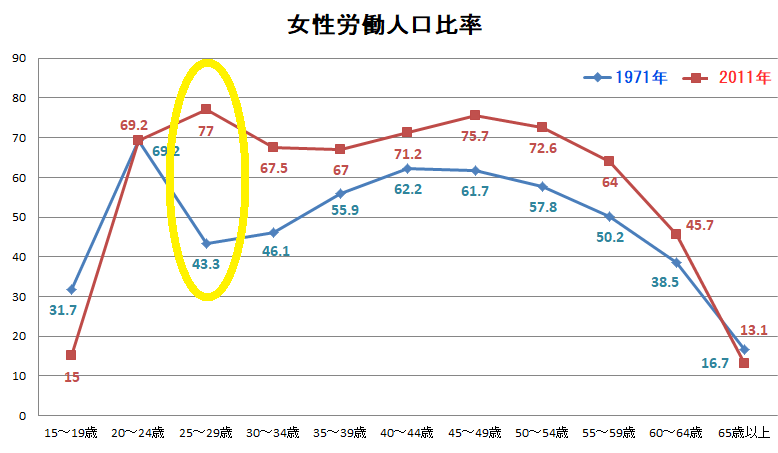問題27
【A】次のグラフが示す1971年と2011年における、我が国の女性の労働人口比率の特徴を、100語程度の英語で簡潔に書きなさい。

模範解答
私が書いたエッセイを見てみましょう
〖私が受験生だったらこう書きます〗
What we can see in this graph is that the percentage of working women in 2011 is higher than that in 1971 on the whole except in the age groups of 15-19 and over 65. One big difference between 2011 and 1971 is in the 25-29 age group. Though the exact same percentage of women worked in the age 20-24 (69.2%) in 2011 and 1971, the percentage in the age group 25-29 in 1971 suddenly dropped very sharply to 42.3% while that in 2011 kept growing up to 77.0%, which is the highest of all age groups.
(97語)

模範解答を見てみましょう
〖模範解答〗
This graph shows the percentages of working women in Japan. In 2011, women in almost all age groups were working. Not much difference is found in each of the 20-24 and 60-65 age groups. However, in the age groups in between, the percentages of working women are considerably higher in 2011 than in 1971. Most Japanese women probably got married by age 30 and stopped working in 1971. But in 2011, women do not quit their jobs that early. In fact, the percentage of working women in the 45-49 age group is very high at 75.7%.
(96語)
ふりかえり
【述べるべき特徴】
①全体的に1971年より2011年のほうが女性の労働人口比率が高い
②☟黄色い〇で示した、1971年の25~29歳の急降下
これくらいを説明するとあっという間に100語になります。

それでは詳しく見てみましょう。
使える表現に下線を引きます。
〖私の模範解答〗
What we can see in this graph is that the percentage of working women in 2011 is higher than that in 1971 on the whole except in the age groups of 15-19 and over 65.
「このグラフから分かることは、15-19歳、65歳以上の年齢階層を除いて、1971年より2011年のほうが働く女性の比率が全体的に高いということである」
One big difference between 2011 and 1971 is in the 25-29 age group.
「2011年と1971年の大きな違いの一つは、25-29歳の年齢階層である」
Though the exact same percentage of women worked in the
「20-24歳の年齢階層では、1971年も2011年も全く同じ比率(69.2%)の女性が働いていたのに」
the percentage in the age group 25-29 in 1971 suddenly dropped very sharply to 42.3%
「1971年の25-29歳の年齢階層が突如42.3%まで急降下している」
while that in 2011 kept growing up to 77.0%, which is the highest of all age groups.
「一方で、2011年の25-29歳の年齢階層は77.0%まで伸び続けている、ちなみにそれは全ての年齢階層の中で一番高い数字である」
※

〖模範解答〗
This graph shows the percentages of working women in Japan.
「このグラフは、日本における女性の労働人口比率を表しています」
In 2011, women in almost all age groups were working.
「2011年は、どの年齢階層でも女性が働いています」
Not much difference is found in each of the 20-24 and 60-65 age groups.
「20-24歳、60-65歳の年齢階層では大きな違いは見られません」
However, in the age groups in between, the percentages of working women are considerably higher in 2011 than in 1971.
「しかし、その間の年齢階層では、1971年より2011年のほうが比率がかなり高くなっています」
Most Japanese women probably got married by age 30 and stopped working in 1971. 「おそらく、1971年ではほとんどの女性が30歳までに結婚して働くのをやめていたのでしょう」
But in 2011, women do not quit their jobs that early.
「しかし2011年では、女性はそんなに早く働くのをやめません」
In fact, the percentage of working women in the 45-49 age group is very high at 75.7%.
「実際、45-49歳の女性の労働人口比率は75.7%ととても高くなっています」